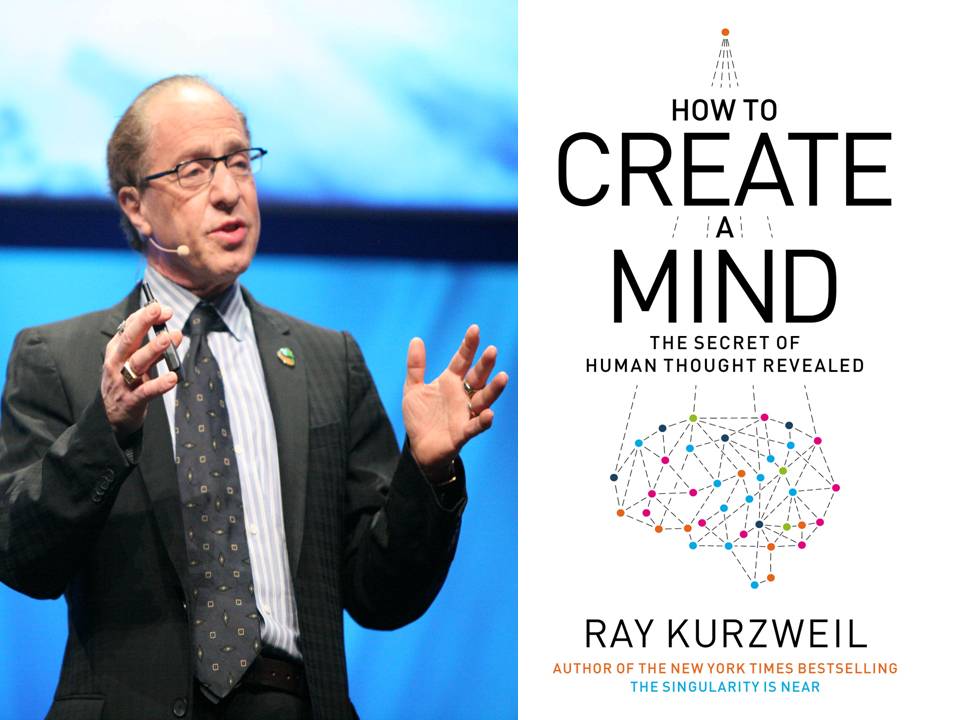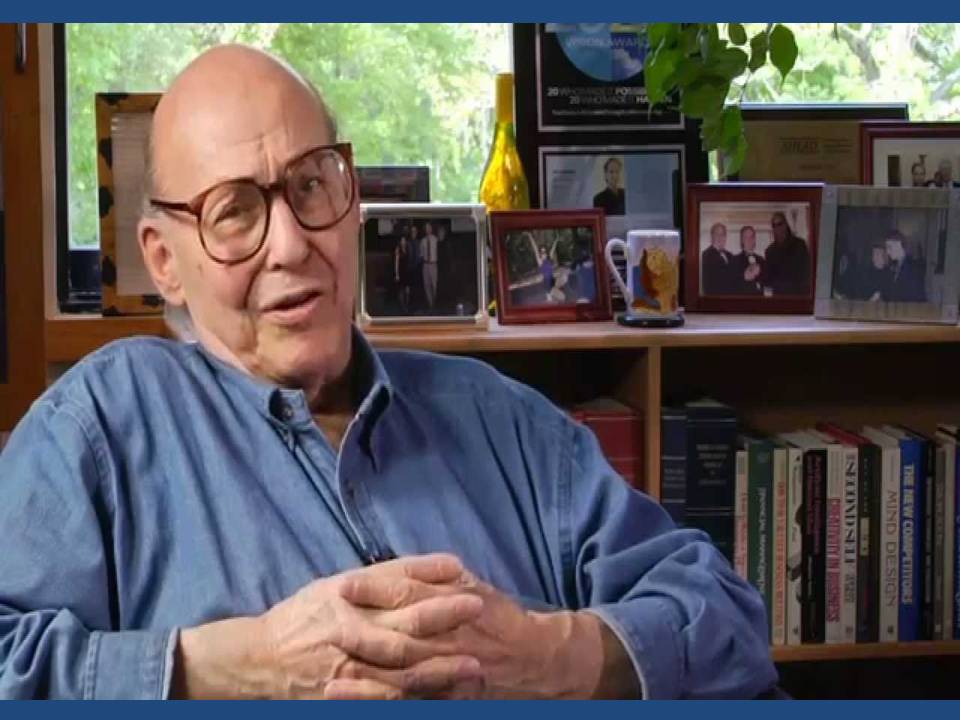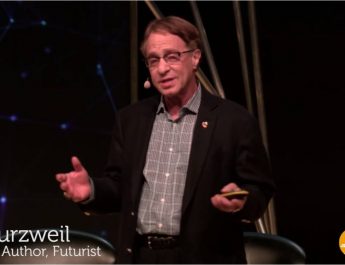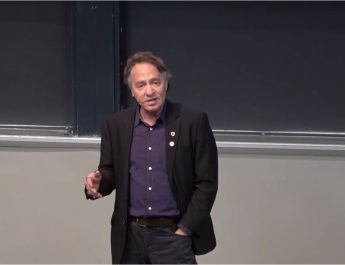“How to Create a Mind: The Secret of Human Thought Revealed” is a non-fiction book about brains, both human and artificial, by the inventor and futurist Ray Kurzweil. First published in hardcover on November 13, 2012, “How to Create a Mind” became a New York Times Best Seller.
Kurzweil describes a series of thought experiments which suggest to him that the brain contains a hierarchy of pattern recognizers. Based on this he introduces his Pattern Recognition Theory of Mind. He says the neocortex contains 300 million very general pattern recognition circuits and argues that they are responsible for most aspects of human thought. He also suggests that the brain is a “recursive probabilistic fractal” whose line of code is represented within the 30-100 million bytes of compressed code in the genome.
Kurzweil then explains that a computer version of this design could be used to create an artificial intelligence more capable than the human brain. It would employ techniques such as hidden Markov models and genetic algorithms, strategies Kurzweil used successfully in his years as a commercial developer of speech recognition software. Artificial brains will require massive computational power, so Kurzweil reviews his law of accelerating returns which explains how the compounding effects of exponential growth will deliver the necessary hardware in only a few decades.
Critics felt the subtitle of the book, The Secret of Human Thought Revealed, overpromises. Some protested that pattern recognition does not explain the “depth and nuance” of mind including elements like emotion and imagination. Others felt Kurzweil’s ideas might be right, but they are not original, pointing to existing work as far back as the 1980s. Yet critics admire Kurzweil’s “impressive track record” and say that his writing is “refreshingly clear”,containing “lucid discussions” of computing history. (wikipedia)
Raymond “Ray” Kurzweil is an American author, computer scientist, inventor and futurist. Aside from futurism, he is involved in fields such as optical character recognition (OCR), text-to-speech synthesis, speech recognition technology, and electronic keyboard instruments. He has written books on health, artificial intelligence (AI), transhumanism, the technological singularity, and futurism. Kurzweil is a public advocate for the futurist and transhumanist movements, and gives public talks to share his optimistic outlook on life extension technologies and the future of nanotechnology, robotics, and biotechnology.





There is no real mystery as to how we produce aspects of the human consciousness program as computer intelligence, or how we produce lifelike simulations. It is a “known” and evidential process. However, the confusion tends to come when that evidential process is replaced with “theories” which seek to explain how the Earth simulation and the human consciousness program could possibly have programmed themselves; when of course, in terms of current computing science, they could not; such a thing would be impossible. If you have a complex program without programmers you have a miracle. Further, if this is a computer simulation, it would require a source dimension where the computers are which generate our dimension, and such computers could not just have manufactured themselves, but would have to have been produced by computer hardware engineers.
All the problems with understanding the simulation argument seem to come from the attempt to insert magical, miraculous and anti-scientific theories into the SA. There is nothing magical, miraculous or mysterious about the process of producing computer simulations and aspects of the human consciousness program.
The question of the original causation of all causes needs to be set aside in all cosmologies, as it is a question with no certain answer.
(quote) Stephen KIng COuld it be that the reason why there is no test for self-awareness is that self-awareness is not a state that can be measured by a device. It is not something physical, (/quote)
Yes, of course, in common with all forms of computer software, the human consciousness program is not physical but metaphysical. A computer is physical, but the programs which it is operates are not physical; they have no weight, shape or spatial dimensions as they are not “physical.”
COuld it be that the reason why there is no test for self-awareness is that self-awareness is not a state that can be measured by a device. It is not something physical, much like how abstract math is not physical.
Can bisimilarity be applied from a machine to itself? For example, at time 0 a simulation of machine X is generated of what X is predicted to do at t1, and at t2 a simulation of X is generated that retrodicts X’s computations at t0.
Stephen KIng (quote) Why is it assumed that only humans are conscious?(/quote). Well I don’t necessarily assume that; I merely suspect it. We already have forms of organic life in simulations, such as trees and animals, which we can animate with simple programs to give the appearance of life; however they are not self-aware, of course. There is no test for self-awareness, even among human beings, and this is also true for the animal world and indeed for all organic lifeforms; they could all just be non-sentient programs; unfortunately, we cannot know, one way or another.
(/quote) Might it be possible that the brain does not operate by processing “lines of code”, but instead is more like a self programming LISP machine? (quote)
I don’t know very much at all about LISP, however LISP is just one of over 500+ major programming languages and it still uses lines of code; I cannot see how that programming language would be superior to any other. With regards to the human consciousness program being “self-learning,” that indeed seems to be the case, but with regards to self-programming in the strict sense of the term, we cannot access our source code and so that would be impossible.
Might it be possible that the brain does not operate by processing “lines of code”, but instead is more like a self programming LISP machine?
Why is it assumed that only humans are conscious?
Kurzwell seems believe that we need to reproduce the human brain on a computer, and attempt to produce consciousness from that; however, I suspect that it will not be as simple that. To reproduce the human consciousness program, is probably the central goal of the AI project, and I “believe” that the secret of programming self-awareness will be cracked eventually, however we really have no idea how to do that yet. It is a mystery. The assumption that Kurzwell is making is that the brain is the organic and electro-chemical computer which produces consciousness; however this may not necessarily be the case; the brain may just be another part of the interactive cartoon avatar form, and while it is at least some kind of interface for the human consciousness program, it may not ultimately be the actual computer which is generating consciousness. I suspect that the human consciousness program and it’s operating system would run into hundreds of millions of lines of code, and that it would not be produced simply be producing an artificial brain.
Does Kurzweil explain how self-directed awareness happens?